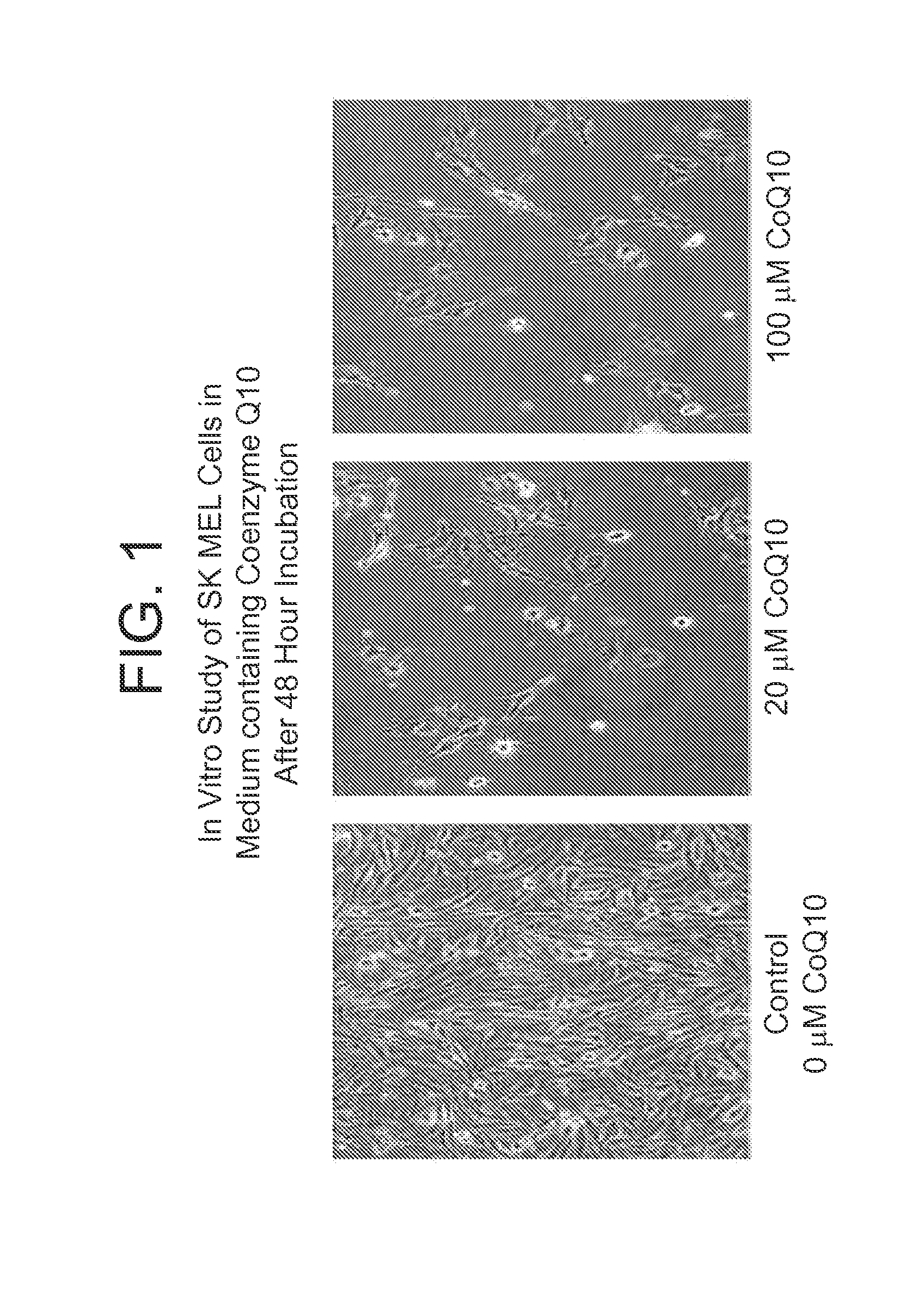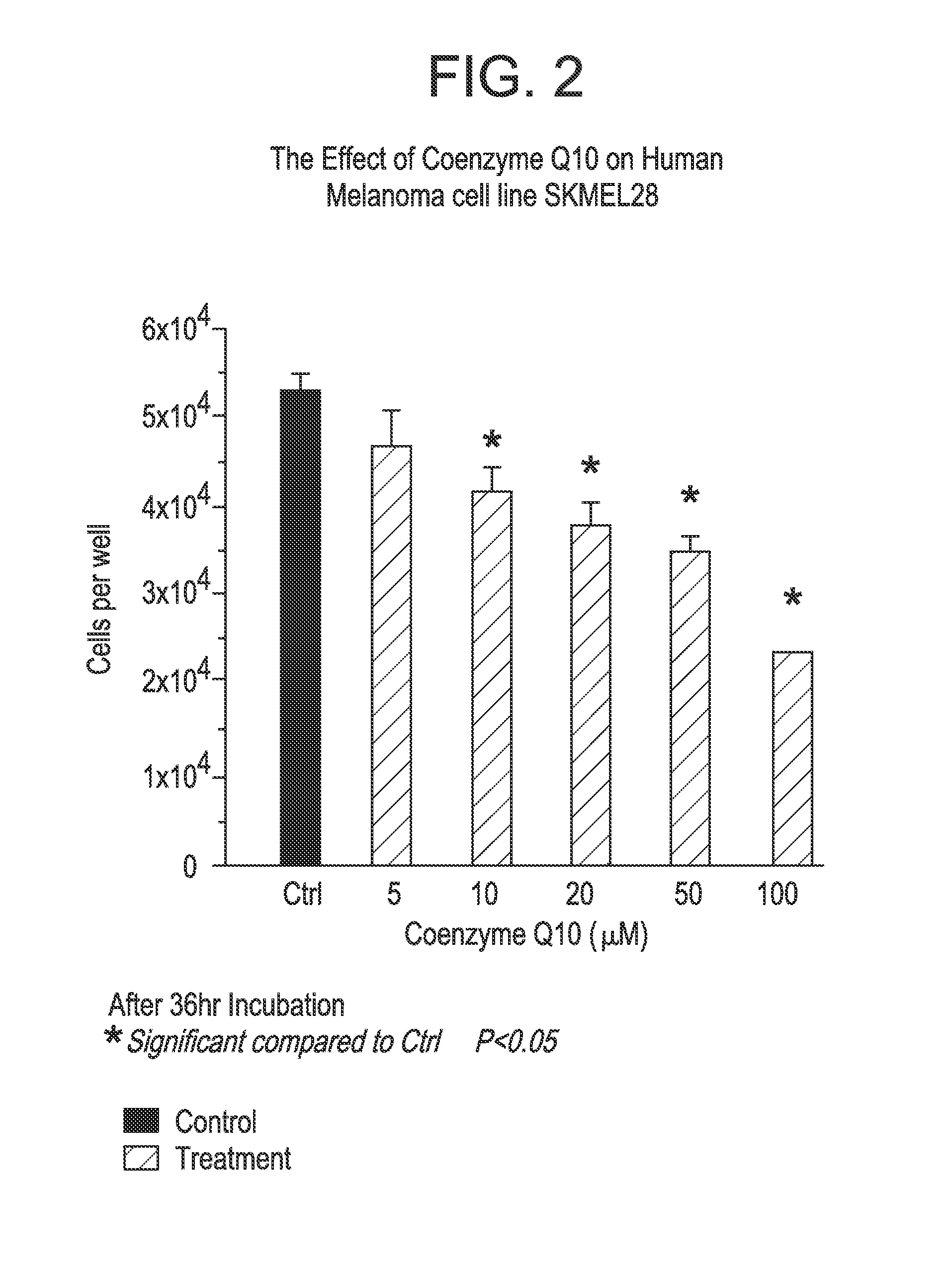Co-enzyme Q10 formulations and methods of use
- Summary
- Abstract
- Description
- Claims
- Application Information
AI Technical Summary
Benefits of technology
Problems solved by technology
Method used
Image
Examples
example 1
Materials and Methods for Apoptosis Assay
[0195]Cell lines used in the assay were SK-Mel28 and nFIB. Cells (SK-Mel28 and nFIB) were seeded (5×104 cells / well) into wells containing either solely medium or medium with treatment and placed in an incubator at 37° C., 5% CO2, and under humidified conditions for 48 hours. Each condition was performed in duplicate and was subjected to the following protocol:
Apoptosis Analysis as Per Protocol of BD Pharmingen Annexin-VPE Protocol
[0196]Reagents include Annexin V-PE (BD Pharmingen, San Diego, Calif.), 7-AAD (BD Pharmingen, San Diego, Calif.), binding buffer (10×: 0.1 M Hepes / NaOH, 1.4 M NaCl, 25 mM CaCl2) [diluted to 1× (9 mL PBS and 1 mL binding buffer) for use in experiment] (BD Pharmingen, San Diego, Calif.), Trypsin-EDTA (Gibco, Grand Island, N.Y.), and desired Media.
[0197]Add 0.5 mL trypsin to each well, remove trypsin after approximately 10 seconds, and add 0.5 mL trypsin to each well. Place wells in an incubator, observe level of detach...
example 2
Effect of a Topical Formulation of Coenzyme Q10 on SK-MEL28 Tumors in Mice
[0254]Melanoma tumors were induced in mice by SK-MEL28 injection into the subcutaneous layer. The animal study consisted of both a control and treatment group each containing four mice. The mice were inoculated with two tumors and the graph of FIG. 14 represents the resulting mean mass for the tumors in each mouse. A topical formulation of Coenzyme Q10 (A 1.0% and 1.5% formulation was tested) was applied to the tumors in the treatment group daily for a period of 30 days. After which, the tumors were excised and the mass was determined. The difference in the overall mean mass of the treatment group was significant compared to the control (P<0.05).
example 3
Preparation of Topical CoQ10 Cream
[0255]Reagents:[0256]Phospholipon 90G (American Lechitin, Stanford, Conn.)[0257]Glycerol[0258]BHT[0259]Ethanol[0260]MCT[0261]lavender (Sigma-Aldrich)[0262]CoQ10 (Pure Prescriptions, San Diego, Calif.)
Procedure:
[0263]10 g of Phospholipon 90G (American Lechitin, Stanford, CT) and 5 g of Phospholipon 90H were dissolved in a mixture of 13.3 g of Glycerol (Sigma-Aldrich, St. Louis, MO), 0.3 g BHT (Sigma-Aldrich), 9 ml ethanol (Sigma-Aldrich), and 1.5 g MCT (Sigma-Aldrich) at 60° C. 1.1 g of CoQ10 (Pure Prescriptions) were dissolved into the resulting mixture. 65 ml of 1 mM phosphate buffer (pH 8.2) prepared with nitrogen saturated water and 0.2 ml of lavender (Sigma-Aldrich) were added and the mixture was blended in a high speed blender at 12,000 RPM to form a cream. The cream was stored at 4° C. until used.
PUM
| Property | Measurement | Unit |
|---|---|---|
| Fraction | aaaaa | aaaaa |
| Fraction | aaaaa | aaaaa |
| Fraction | aaaaa | aaaaa |
Abstract
Description
Claims
Application Information
 Login to View More
Login to View More - R&D
- Intellectual Property
- Life Sciences
- Materials
- Tech Scout
- Unparalleled Data Quality
- Higher Quality Content
- 60% Fewer Hallucinations
Browse by: Latest US Patents, China's latest patents, Technical Efficacy Thesaurus, Application Domain, Technology Topic, Popular Technical Reports.
© 2025 PatSnap. All rights reserved.Legal|Privacy policy|Modern Slavery Act Transparency Statement|Sitemap|About US| Contact US: help@patsnap.com



